Standing out as an eco-friendly type of viscose fabric, EcoVero Viscose opens an important door in the world of sustainable textiles. This material is produced from recyclable pulp derived from responsibly sourced wood and reflects a strong commitment to environmental responsibility.
First introduced to the market by Austria-based viscose manufacturer Lenzing, EcoVero Viscose is also known as viscose in our country. This product adopts sustainable wood and paper production processes and has gained significant interest from environmentally conscious individuals and brands. EcoVero Viscose, which has been certified according to international ecological standards, is a type of fabric you can choose with confidence.

You can click on the image above to view our product.
Structural Features of EcoVero Viscose
EcoVero Viscose draws attention with approximately 50% lower water consumption and emission impact compared to traditional viscose. Its raw material consists of cellulosic fibers obtained from renewable resources.
The fabric is known for its silky and soft texture and is preferred by consumers with high environmental awareness as an alternative to silk fabrics. Its smooth surface and lightweight structure provide comfort. Although it is not elastic on its own, it can gain stretch when blended with elastic materials. Therefore, it is a reliable option in terms of durability.
Thanks to its cellulosic fiber structure, the fabric absorbs and releases moisture, offering breathability. With the ability to absorb four times its weight in water, it helps regulate body temperature, making it an ideal choice for summer clothing. It is fully biodegradable within a few months in nature, causing no harm to the environment. For this reason, it is a great option for plus-size blouses and skirts for the summer season.

Care Tips for EcoVero Viscose
EcoVero Viscose, produced through eco-friendly processes, is a soft and durable textile product. Proper care is essential to ensure it remains stylish and long-lasting. When washing these garments, use a gentle cycle at a low temperature—ideally 30°C—and avoid harsh detergents. During drying, steer clear of direct sunlight and opt for natural air drying. Also, iron garments inside out. For example, with black plus-size pants, turn the fabric inside out and iron at a low temperature to preserve its quality.
Differences Between EcoVero Viscose and Other Fabrics
Thanks to its breathable structure, EcoVero Viscose typically does not cause sweating. Unlike petroleum-based synthetic fabrics like nylon—which may be durable and water-resistant but uncomfortable in humid conditions—EcoVero Viscose provides superior moisture regulation when combined with the right fabric types. Made from natural materials, it is more breathable and skin-friendly than nylon. Its ability to absorb and release moisture gives a refreshing feeling on the skin.
When choosing between EcoVero and cotton, consider the purpose of use. Although EcoVero is less durable than cotton, it offers a softer touch and silkier look, making it a better option for summer wear. For instance, you can prefer plus-size viscose T-shirts during hot weather.
Another environmentally friendly innovation is Livaeco Viscose, a fabric developed with sustainability in mind. Like EcoVero, it is produced from responsibly sourced raw materials and designed to minimize the carbon footprint.

Click on the image above to view our product.
EcoVero Viscose Fabric and Sustainability
What distinguishes EcoVero Viscose most clearly is its commitment to sustainability. The cellulose used in its production is proven to come from sustainable forest sources.
If you want to ensure your clothes are environmentally friendly, EcoVero fabrics carry the EU Ecolabel, an internationally recognized certification of ecological responsibility. Garments made from this material are biodegradable and return to nature within a few months after use.
Another strength of EcoVero is supply chain transparency. Consumers can trace the entire process from raw material sourcing to production, distribution, and recycling through a sophisticated tracking system. This transparency increases consumer trust in the sustainability of the fabric. For high-quality clothing made from such materials, you can explore Luokk’s product range.









